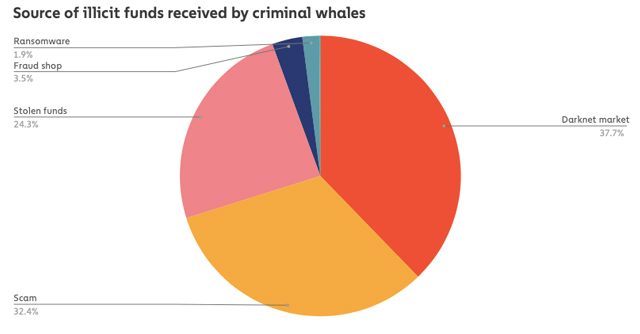
Stolen funds the biggest source of criminal crypto holdings: Chainalysis


Cryptocurrency holdings among cyber criminals saw a massive surge in 2021, rising from around $3 billion in 2020 to over $11 billion in 2021. In this, the biggest source of funds among criminals happen to be stolen funds, which contributed to $9.8 billion (or 83 percent) of all crypto holdings with criminals in 2021, according to a report by blockchain data platform, Chainalysis.
The 2022 Crypto Crime Report by Chainalysis further states that nearly 4 percent of all cryptocurrency ‘whales’ were linked to funds received from illicit addresses in 2021, amounting to holdings of over $25 billion (~Rs 1.87 lakh crore) in crypto tokens.
‘Whales’ is a term that is typically used to refer to cryptocurrency wallets with tokens worth more than $1 million stored in them. ‘Criminal whales’, meanwhile, refer to crypto wallets where at least 10 percent of the funds were credited from sources that are blacklisted or marked as illicit by exchanges, law-keeping bodies and security agencies.

The report details how cryptocurrency crimes have been on a rampant rise through 2021, especially stolen funds. Multiple reports of funds stolen from decentralised finance (DeFi) platforms have surfaced, with information from crypto data tracker The Block showing a rise of over 20x year-on-year (YoY) in crypto funds stolen through DeFi platforms in October 2021. According to this, attackers exploited coding flaws in flash loans, or non-collateralised cryptocurrency loans, to steal funds.
In January 2022, blockchain security firm CertiK stated that stolen cryptocurrencies crossed a billion dollars in 2021, led by coding discrepancies on DeFi platforms. Chainalysis’ report shows that attackers have clearly exploited this the most.
In terms of criminal cryptocurrency balances, the Dark Web markets contributed $448 million through 2021, followed by $192 million from scams, $66 million from organised fraud and $30 million from ransomware. Interestingly, the 2022 Global Threat Report by cyber security firm CrowdStrike showcased how Iranian hackers were the biggest contributors to ransomware activity in the world through 2021 – which led to the above figure.


Credit: Chainalysis
According to Chainalysis, in terms of the criminal whales, the biggest contributing sector was the Dark Web marketplaces – 37.7 percent of all funds credited to criminal whales in 2021 came from here. Scams and stolen funds were the next largest contributors, accounting for 32.4 percent and 24.3 percent of the $25 billion figure. Frauds and ransomware cumulatively accounted for the remaining 5.4 percent.

However, Chainalysis says that despite a watershed year for criminals in cryptocurrencies, law enforcement agencies have not been entirely steamrolled. The data underlines recoveries such as $2.3 million from the Colonial Pipeline hackers in USA, $3.5 billion by the US Internal Revenue Service, and the London Metropolitan Police Service’s recovery of $180 million.
“These stories are important not only because they allow financial restitution for victims of cryptocurrency-based crime, but also because they disprove the narrative that cryptocurrency is an untraceable, unseizable asset perfect for crime. If cyber criminals know law enforcement is capable of seizing their cryptocurrency, it may lower their incentive to use it in the future,” the report added.
